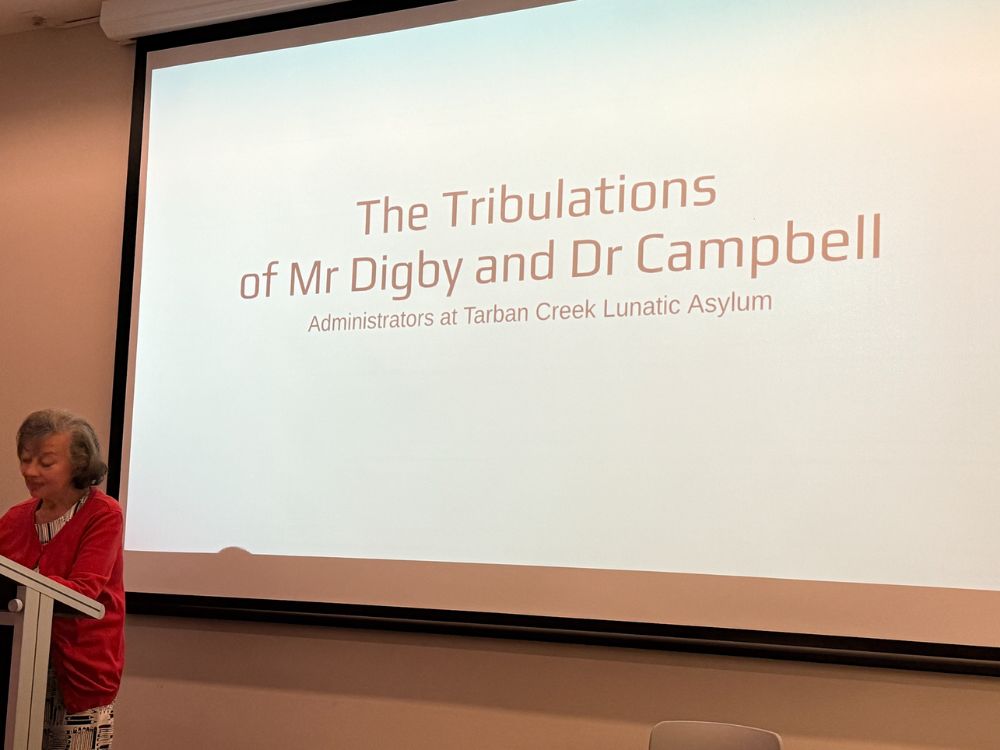On Tuesday, 28 October 2025, the Lane Cove Historical Society (LCHS) announced its 2025 History Prize Winner.
In addition to announcing the winner, Pam Palmer, LCHS president, announced that the Lane Cove History Prize had been renamed the Frances Christie History Prize.
In July 2025, Professor Francis Christie passed away.
She led a remarkable life, which you can read about here. Frances worked tirelessly to organise and promote the LCHS History Prize, so it is only fitting that the award should be named in her honour.
A highly commended prize was awarded to Barbara Palmer for her essay titled “Aminya Place: Its History and Its Community Spirit.” Barbara will present her essay at a Lane Cove Historical Society meeting next year.
The Winner – Christina Faulk
The essay will be published in the LCHS Journal, archived in the LCHS Collection, and given to the Local Studies Unit of the Lane Cove Library. This project will primarily benefit the residents of Lane Cove. However, it will also enrich the reserves of historical research within New South Wales and Australia.
The Winning Essay
- Tarban Creek Lunatic Asylum (1838-1868)
- Gladesville Hospital for the Insane (1868-1914)
- Gladseville Hospital 1915 – 1993
The site is owned by the NSW government and is used as offices and for community activities.

Mr Digby and Dr Cartwright
Christina’s essay focuses on two of the earliest superintendents of the Tarban Creek Lunatic Asylum and highlights how, in the early 19th Century, mental health treatment was rudimentary. The essay examines the tense relationship between Mr Digby, a non-medical superintendent and Dr Campbell, an ambitious physician.

Patients were usually brought to the Asylum by the police, and it was not uncommon for some patients to pass away within a day of arriving at the Asylum.
The first Superintendent, Mr Digby, was not a medical practitioner, and patients were restrained with straitjackets. Governor Sir Richard Bourke selected Mr Digby as he had experience in the administration of mental institutions in England. Mr Digby and his wife (who was appointed Matron) relocated from England to take up the position as Superintendent.
Mr Digby’s correspondence (outlined in the winning essay) with the Governor is fascinating, as authorities routinely rejected requests for soap or hay for mattresses. However, the requests show a man dedicated to his role.
The second superintendent was Dr Campbell. When he first arrived at the Asylum, he reported to Mr Digby. He disagreed with Mr Digby’s methods, and he took steps to undermine him. Mr Digby’s methods as superintendent were made public when letters to the editor were published in the Sydney Morning Herald. The letters were written under a non-de-plum and argued strongly that mental asylums should be run by medical staff.
Eventually, Dr Campbell was appointed superintendent following government inquiries, and he immediately began making changes, including removing restraints.
In an article called Lunacy and Idocy published on the NSW Health Department’s website the author notes:
“Campbell’s fame rests upon his reputation as a clinician. He introduced concepts of non-restraint, adequate diet, planned recreation and clinical regimes. He failed as an administrator and was personally criticised to Henry Parkes by Surgeon George Walker as ineffectual.”
Memorial
In December 2019, the Mental Health Commission of New South Wales held a memorial to acknowledge and remember the lives of former residents of the Gladesville Psychiatric Hospital on Victoria Road in Gladesville.
The following is noted on the NSW Mental Health Commission website:
“The Gladesville Hospital Cemetery is the final resting place of more than 1,200 former patients and several staff. Almost all the graves are unmarked — an indication of the high level of ignorance and shame that pervaded attitudes towards those who experienced mental health issues in the past.”
Judges
A judging panel selected the winning essay.
Laila Ellmoos
Laila Ellmoos is a historian with the City of Sydney’s History Program. She is the author of three books, including Our Island Home: A History of Peat Island. Laila was the President of the Professional Historians Association of NSW from 2010 to 2013. She has also worked extensively as a heritage consultant in the private sector.
Kay Leiper
Dr Kay Leiper is the LCHS Vice President and former President.
Lane Cove Historical Society
The Lane Cove Historical Society curates the Historic Carisbrook House on Burns Bay Road, Lane Cove.
Purchased as a house museum, Carisbrook remains an important reminder of Lane Cove’s history. Carisbrook is a survivor of a time when the land around the Lane Cove River was a world away from Sydney Town. Built in the 1880s from locally quarried sandstone, the house sits handsomely overlooking Burns Bay to the east and the Lane Cove River to the west.
The Lane Cove Council purchased Carisbrook as a gift to the Lane Cove community. The Heritage Council of NSW placed a permanent conservation order on the house in 1981. It is now maintained by Lane Cove Council and curated by the Lane Cove Historical Society.
Find out more about Carisbrook House here.
Members of the public can tour Carisbrook House on the Monthly Open Weekend. The next open weekend is on
Carisbrook Historic House is open on the third weekend of every month (except December).
Take a self-guided tour of the House and enjoy Devonshire Tea or coffee and cakes in the courtyard.
To find out more about the Lane Cove Historical Society and its monthly talks, click here.














